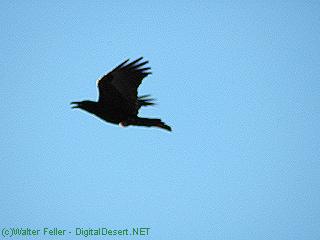Raven

Common Raven Corvus corax
Family: Corvidae Order: Passeriformes Class: Aves
DISTRIBUTION, ABUNDANCE, AND SEASONALITY
A fairly common to common, yearlong resident throughout most of California, with a few
exceptions. Rare in the Central Valley, at high elevations in the Sierra Nevada, and along the
central California coast (Santa Cruz to Santa Barbara cos.). Numbers appear to be
increasing in the northern Sacramento Valley and the Cascades (McCaskie et al. 1979).
Found at all elevations throughout the state. Some downslope movement in mountains in
winter (Gaines 1977b). Occurs in most habitats. Resident on the Channel Islands (Garrett
and Dunn 1981). Nested regularly on the Farallon Islands until extirpated in 1911 (DeSante
and Ainley 1980).
SPECIFIC HABITAT REQUIREMENTS
Feeding: Eats carrion, small vertebrates (including mice and rabbits), bird eggs and
young, insects, seeds and grains, nuts, and berries and other fruits (Bent 1946). Gleans from
the ground, searches for food in flight, and pursues prey. Caches food. Ejects pellets.
Cover: Trees and cliffs in a wide variety of habitats provide cover. Roosts in colony at
night, mostly in trees.
Reproduction: Nest is a mass of twigs and sticks bound with earth and moss and
well-lined with soft vegetation and hair (Harrison 1978). Nest usually placed on cliff or bluff,
but also in a tall tree or human-made structure. Mostly 6.1 to 30 m (20-100 ft) above ground.
On cliff, may nest within 100-200 m (350-700 ft) of prairie falcon nest (Dawson 1923, Mewaldt
personal observation). Sometimes uses old raptor nest (Airola 1980).
Water: No information found.
Pattern: Grinnell and Miller (1944) noted 2 features usually present in occupied habitat:
large expanses of sparse, open terrain for foraging, and cliffs, bluffs, or sea walls for nest
sites.
SPECIES LIFE HISTORY
Activity Patterns: Yearlong, diurnal activity.
Seasonal Movements/Migration: Mostly a yearlong resident. May wander or move
downslope from high elevations in winter. Little information available about movements or
other aspects of life history of populations in western U.S., especially in mountainous areas.
Home Range: In Wyoming, home range averaged 938 ha (2317 ac), varying from
680-1080 ha (1680-2668 ac) (Craighead and Craighead 1956). In Great Britain, breeding
density reported as 1 pair per 17-46 km˛ (6.6 to 17.6 mi˛) (Ratcliffe 1962). In Virginia, 1 pair
per 29 km˛ (11 mi˛) reported by Hooper et al. (1975).
Territory: Defends a territory, but no data found on size.
Reproduction: Pair nests solitariIy from mid-February into July with peak activity in May
and June. Lays 3-7 eggs, usually 4-6; incubated by female for 20-21 days. Male feeds
incubating female. Altricial young tended by both parents. Nestlings fledge at 5-6 wk
(Harrison 1978).
Niche: Preys on bird eggs and young as well as on small vertebrates. Also feeds on
carrion and at dumps.
California Department of Fish and Game. California Interagency
Wildlife Task Group. 2005. California Wildlife Habitat Relationships version 8.1 personal computer program. Sacramento, California.
Also see:
Bird,
Omnivore,
Scavenger,
Predator,
Diurnal

The murderous-looking jetblack Raven (Corvis corax) average about 24 inches in length and have a fan-shaped tail rather than the square tail of their cousins, the crows. They are omnivores but prefer animal over vegetable foods. They often eat carrion but have been known to attack live lizards, snakes, insects and nesting birds. They most often travel in pairs.




